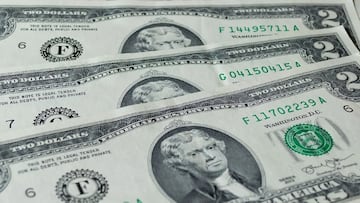$2 bills that could be worth more than $4,500: do you have any?
An estimated price list published by US Currency Auctions suggests that some $2 bills can be worth hundreds or even thousands of dollars. Do you have one?

An estimated price list published by US Currency Auctions suggests that some $2 bills may be worth hundreds or thousands of dollars. According to the aforementioned company, the dollars that are still in circulation have a variable average value that ranges from $2 to $2,500, depending on the year.
The $2 bills that are no longer in circulation have a moving average value ranging from $2 to $4,500, which also depends on the year of release and other physical factors.
According to the auction, there are two out-of-circulation $2 bills that are worth up to $4,500. Interestingly both are from 1890, one with a brown stamp and the other with a red stamp.
Many $2 bills listed on eBay, a popular multinational auction website, are packaged in sets that range in price from a few dollars to $10,000.
Why are $2 bills considered bad luck?
For a long time, the $2 bill was considered bad luck. This is because an urban legend claims that, at one point, voter fraud was common and the reward for a favorable vote was $2. There was a belief that politicians would buy votes for $2, so having a $2 bill could be seen as evidence that you had sold your vote.
The $2 bill was often thought to bring bad luck, as “deuce” was a name used for the devil. Recipients would tear off a corner, believing it would negate the bill’s bad luck.
History of the $2 bill
The first $2 bill appeared in 1862 and featured a portrait of Alexander Hamilton, the first Secretary of the Treasury according to the US Bureau of Engraving and Printing. His rendering was replaced with that of Thomas Jefferson on Series 1869 United States Notes. Hamilton was put on the $10 bill in 1928.
Starting on the 1928 Series, Monticello, Thomas Jefferson’s estate in Virginia featured as the vignette on the back of the bill. However, in 1976, to celebrate the United States’ bicentennial, Jefferson was kept on the face but the vignette on the back was changed to John Trumbull’s painting of the signing of the Declaration of Independence.
This is the current format of the $2 bill with no plans to change. The Series 2017A was the most recent series to be printed.






